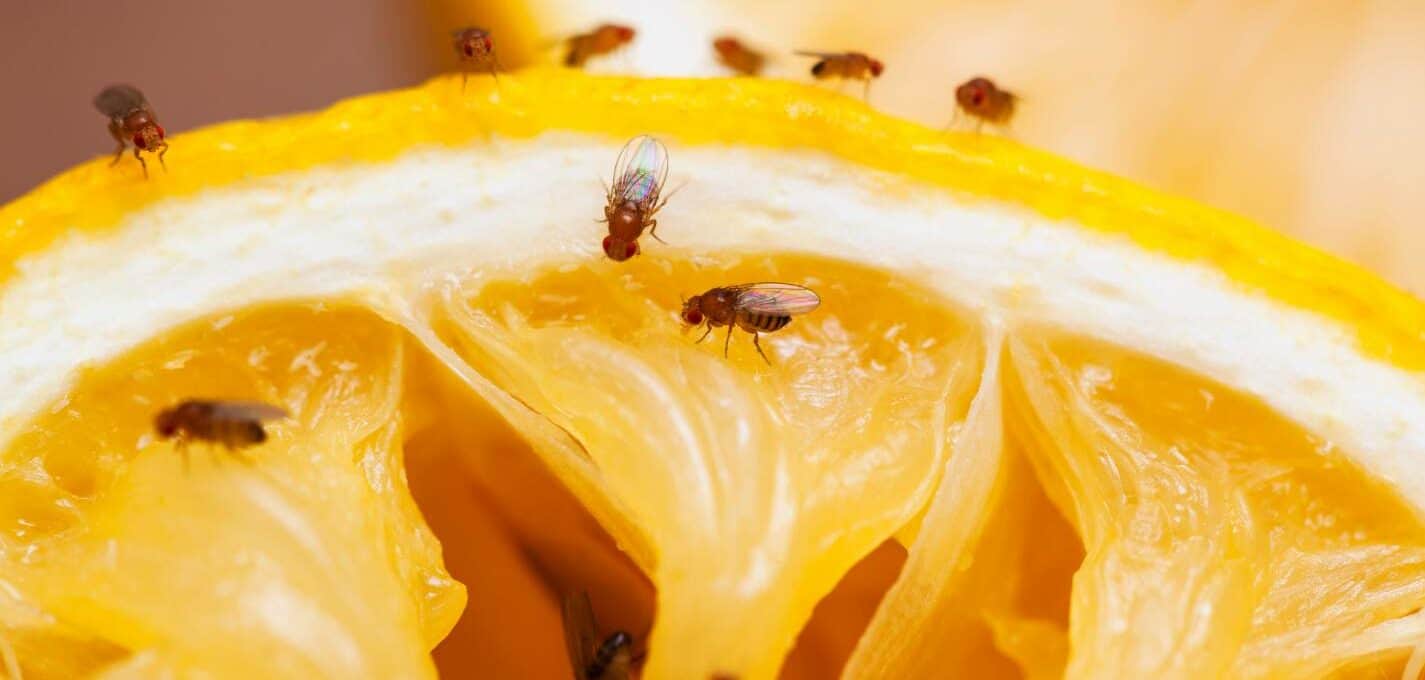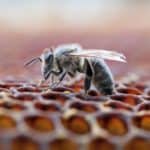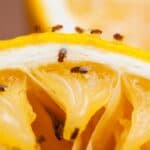What attracts fruit flies and how to prevent them from coming back
Nearly everyone has a fruit fly story to tell. The little buggers are really hard to get rid of! No one likes fruit flies, especially when they try to fly up your nose or into your eyes.
And once you realize they are laying their eggs in your kitchen and that they carry bacteria and harmful microbes, well, that is that. It is time to take action.
Ridding your space of fruit flies is a two-part job. First, you have to know what attracts them and remove that. Then you have to make your space unfriendly so they will not return. Keep reading to find out how.
What Attracts Fruit Flies?
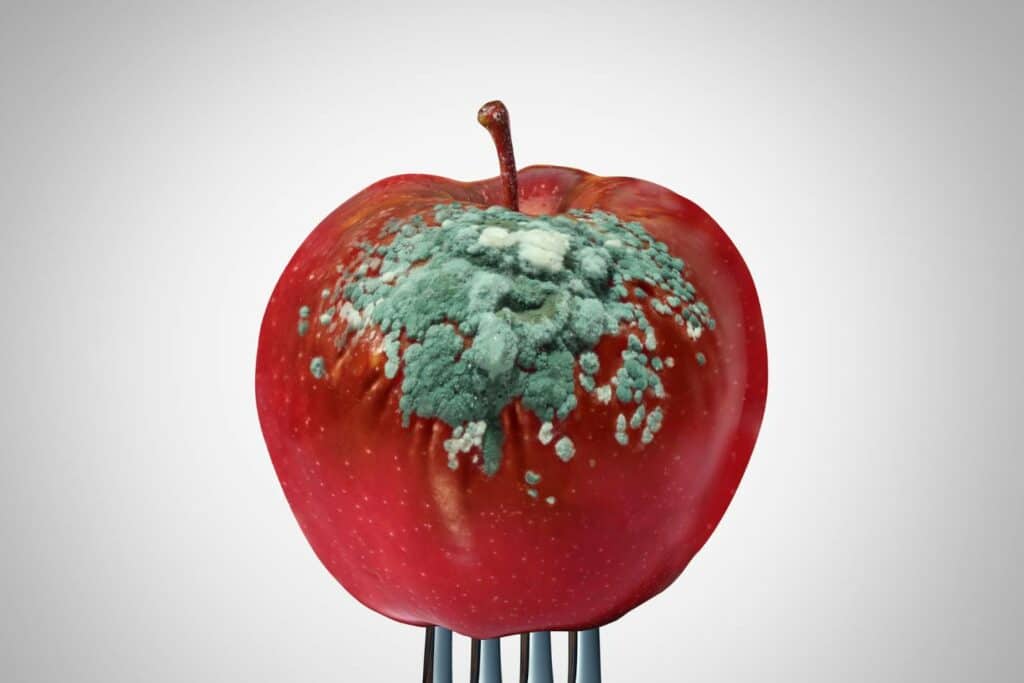
Fruit flies get their insect name, honestly. They are primarily drawn to overripe, fermenting, rotting, and decaying fruit. But fruits are not the only organic matter fruit flies like. They can be drawn to anything moist or damp, molding or decaying. Vegetables, bread, starches, juice, milk, and alcohol can lure them in.
Sometimes fruit flies will even be attracted to non-food items if water is present. Examples include damp mops, sponges, rags, and even standing water. The key to remember is that fruit flies will be drawn to anything organic that is actively overripe, fermenting, rotting, mildewing, or molding in some way.
Why Do Fruit Flies Like Ripe and Rotting Foods?
Fruit flies have two main reasons for congregating near ripe and rotting food and other damp or moist organic matter.
The first reason is that they are hungry. The second reason is that they are about to breed and lay eggs. Their offspring will need protection while they are incubating, and then they will be hungry when they hatch.
Fruit flies ready to lay eggs will first use their tiny mouthparts to puncture holes in anything fermenting or actively rotting. They eat and then lay their eggs inside the food or organic matter.
Then when the larvae hatch, they have a ready food source to feed on.
You are probably reading this and thinking, “yuck!” But to a fruit fly, it is the perfect system to meet their needs and pass on their genes to the next generation.
How Do You Know You Have Fruit Flies?
Fruit flies are not the only flying insects that like ripe or rotting fruits and produce and fermented foods and liquids.
So how do you know that the insects you are trying to get rid of are actually fruit flies?
This is a very important question! To make sure you prevent the insects from coming back again, you first need to know what species you are dealing with.
Here is a common example:
Drain flies, which are small flies that breed in drains where small amounts of rotting organic matter and moisture is present, are quite similar to fruit flies. It is easy to get the two species confused.
But the method for getting rid of drain flies is different than what you need to do to get rid of fruit flies. So it is essential to be able to tell the two species apart.
A drain fly looks more like a tiny moth, while a fruit fly looks more like a tiny fly.
Here is another common example:
Sometimes you may see tiny black things buzzing around your houseplants. A lot of times, these fungus gnats are mistaken for fruit flies. But fungus gnats, like drain flies, look different when you can see them up close.
A fungus gnat looks more like a very tiny mosquito and it won’t have red eyes.
What Do Fruit Flies Look Like?
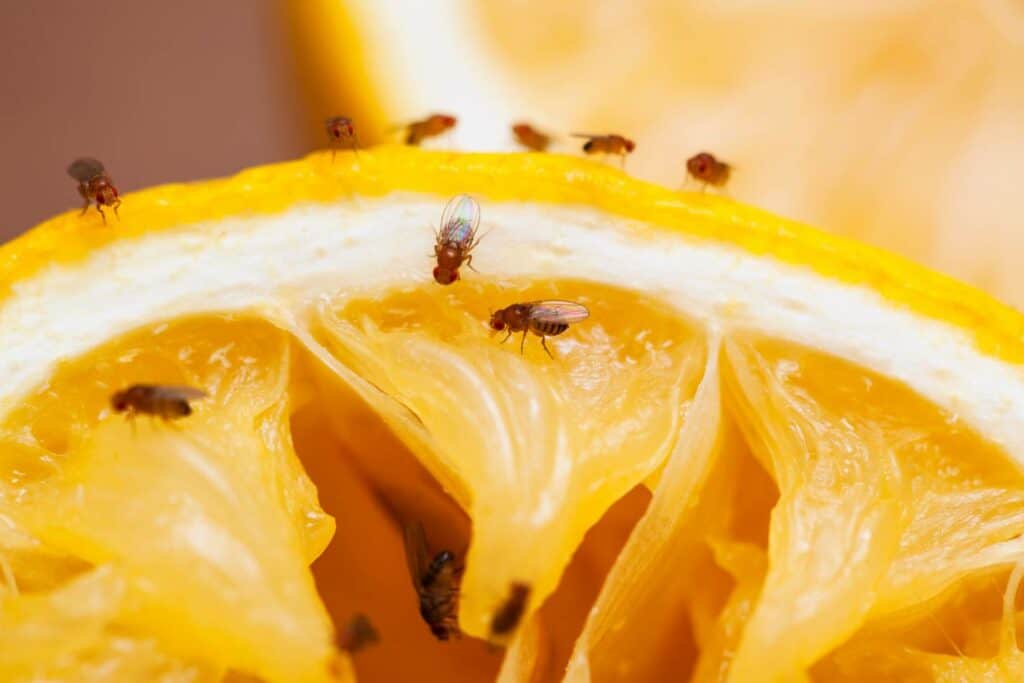
So let’s discuss what adult fruit flies look like to determine if you have a fruit fly problem. An adult fruit fly is going to be about one-eighth inch long. It will have red eyes. Its body will be tan or brown on the front (nearest the head) and black on the back.
Undoubtedly, getting a good up-close look at a tiny buzzing fruit fly can be hard. But if what you are looking at looks a lot like a regular fly, only smaller and with a two-tone body and reddish eyes, it is most likely a fruit fly.
Once you’ve made an identification, it is time to switch to preventative mode and eliminate your fruit flies!
What Gets Rid of Fruit Flies?
Fruit flies can be hard to tolerate, especially once you know they are infesting your produce and other places with their eggs! If you are desperate, its probably a good idea to implement several traps around the house until they are gone. Then you can move on to more permanent measures.
We recommend a simple trap like Terro Traps:
4 Steps to Rid Yourself of Fruit Flies for Good!
These tiny uninvited guests can quickly transform your peaceful abode into their party pad. But don’t fret, because I’m here to equip you with four steps to evict these nuisances for good!
Step 1: Take Away Their All-You-Can-Eat Buffet!
First things first, let’s cut off their food supply. I mean, if they’re going to crash our place, they can at least bring their own food, right?
Ready For A Thorough Cleanup?
Turn on your favorite tunes, slip on your cleaning gloves, and get ready to scrub! A meticulous deep clean is the order of the day. Remember, it’s not just your overripe fruits that these freeloaders are attracted to. That tiny spill in your pantry or the crumbs under your couch, it’s all a gourmet feast for them!
Step 2: Lock Up Your Groceries
The next thing on our agenda is smart food storage.
Proactive Storage Techniques
You don’t need to swear off your favorite fruits or juices. Instead, be more mindful of storage. Keep a vigilant eye on the expiry dates, and promptly refrigerate or dispose of anything that could attract these party crashers.
Step 3: Uncover Their Secret Hideouts
Alright, it’s time to put on our detective hats! You’ll need to identify potential hotspots where these fruit flies have set up shop.
Sleuth and Sweep
Some colonies are easy to spot. A rotten tomato acting as a fruit fly magnet? Found it! But for those hidden nooks and crannies, you’ll need to play detective. Spot a fruit fly? Follow its flight path. It could lead you to unseen infestations—drains, garbage disposals, trash cans, recycling bins, or compost piles. Once you’ve found their secret lairs, it’s time for cleanup!
Step 4: Employ All Necessary Countermeasures
Is the fruit fly problem getting out of hand? It’s time to consider more intensive measures.
Natural Repellents and Homemade Traps for Fruit Flies
When dealing with fruit flies, sometimes the best solutions can be found right in your home. Here’s a list of natural repellents and DIY traps to help you fight the fruit fly invasion.
Natural Repellents
- Essential Oils: Many essential oils, such as lemongrass, peppermint, eucalyptus, and tea tree oils have strong scents that fruit flies dislike. Add a few drops of these oils to a spray bottle filled with water and spritz around your home.
- Camphor and Citronella Candles: The strong smells from these types of candles can help deter fruit flies. Just light them and place them strategically around your home.
- Herbs and Plants: Plants like basil, lavender, lemongrass, and mint can naturally deter fruit flies. You can grow these plants in pots and place them around your home.
Homemade Traps
- Apple Cider Vinegar Trap: Fill a jar or a bowl with apple cider vinegar and add a few drops of dish soap. The vinegar attracts the fruit flies, and the dish soap reduces the surface tension of the vinegar, causing the flies to drown.
- Wine or Beer Trap: Like the vinegar trap, fruit flies are attracted to the smell of fermented drinks. Just pour a little wine or beer into a container, cover it with plastic wrap, and poke some small holes in the top. The flies will crawl in but won’t be able to get back out.
- Fruit Trap: Place some overripe or rotting fruit in a bowl, cover it with plastic wrap, and poke holes in it. This trap will lure the flies in with the fruit scent, but they’ll be unable to escape.
Here’s a summarized table of the information:
| Type | Method | Procedure |
|---|---|---|
| Natural Repellents | Essential Oils | Add to water and spray around the house |
| Natural Repellents | Camphor/Citronella Candles | Light and place around the house |
| Natural Repellents | Herbs and Plants | Grow and place around the house |
| Homemade Traps | Apple Cider Vinegar Trap | Fill a jar with vinegar and a few drops of dish soap |
| Homemade Traps | Wine/Beer Trap | Pour into a container, cover with plastic wrap |
| Homemade Traps | Fruit Trap | Place overripe fruit in a bowl, cover with plastic wrap |
These natural repellents and homemade traps are great tools in your fight against fruit flies. With a bit of patience and persistence, you can make your home an unattractive place for these pests!
In the End, Prevention is the Key to a Fruit Fly-Free Home
Remember, preventing a problem is always easier than solving it. So, maintain cleanliness, deal quickly with spills, and store food properly. And most importantly, keep the lids of your trash and recycling bins firmly closed. These preventative measures can help you keep these bothersome creatures at bay.
With this comprehensive strategy in your arsenal, you’re on your way to reclaiming your home from these annoying invaders. Stay consistent with these steps; a fruit fly-free home isn’t far off. Happy cleaning!

